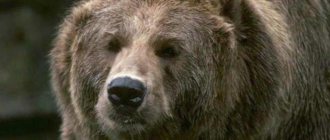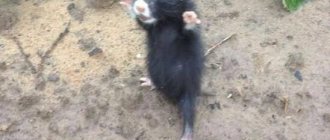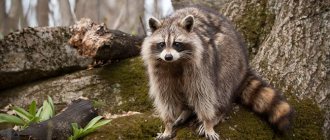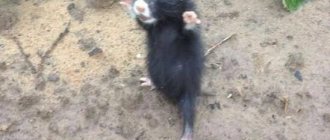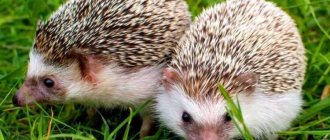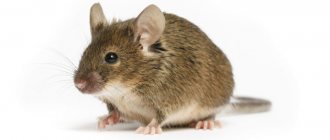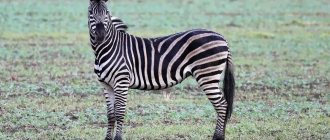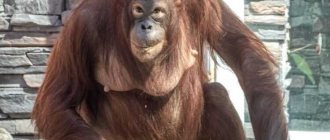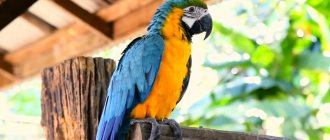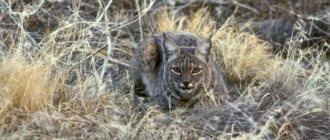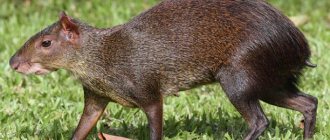- Wild animals
- >>
- Mammals
The Arabian oryx is one of the largest desert mammals in the Arabian region, and has been an important aspect of its heritage throughout history. After becoming extinct in the wild, it is reintroduced to the dry Arabian Peninsula. This species is a desert antelope that is highly adapted to its harsh desert environment.
Origin of the species and description
Photo: Arabian Oryx
Nearly 40 years ago, the last wild Arabian oryx, a large cream-colored antelope with striking black horns, met its end in the deserts of Oman - shot dead by a hunter. Unregulated hunting and poaching led to the animals' initial extinction. After this, the population was saved and restored again.
Genetic analysis of the reintroduced Omani population of Arabian oryx in 1995 confirmed that all genetic variations of the native population were not present in the reintroduced population. However, no association was found between inbreeding coefficients and fitness components, although associations were found between measures of microsatellite DNA variation and juvenile survival, indicating both inbreeding and inbreeding depression. Oman's high rate of internal population growth suggests that concurrent inbreeding is not a major threat to population viability.
Video: Arabian Oryx
Genetic data showed that low but significant population differentiation was found between most Arabian oryx groups, suggesting that management of the Arabian oryx has resulted in significant genetic admixture between populations.
Previously, people thought that this majestic animal had magical powers: the animal’s flesh was supposed to give extraordinary strength and make a person insensitive to thirst. It was also believed that the blood helped against snake bites. Therefore, people often hunted this antelope. Among the many local names used to describe the Arabian oryx is Al Maha. A female oryx weighs about 80 kg, and males about 90 kg. Occasionally males can reach 100 kg.
Fun Fact: The Arabian Oryx lives for 20 years both in captivity and in the wild if environmental conditions are good. During drought, life expectancy is significantly reduced.
Etymology
The taxonomic name is Oryx leucorix
from Greek
Orux
(gazelle or antelope) and
leucosis
(white).
The Arabian oryx in English is also called the white oryx, disgrace
in Hebrew,[5] and is known as
maha, wudhayhi, baqar al-wahsh
, and
Boosolah
in Arabic.[6]
Prussian zoologist Peter Simon Pallas introduced "oryx" into scientific literature in 1767, applying the name to the common eland as Antelope Oryx
(Pallas, 1767).
In 1777 he transferred the name to Cape Gemsbok. At the same time, he also described what is now called the Arabian oryx as Oryx leucorix
, labeling its range as "Arabia and possibly Libya".
In 1816, Henri Marie Ducrotet de Blainville split the antelope group, adopted Oryx
as the genus name, and changed
Oryx Pallas antelope
to
Oryx gazella
(de Blainville, 1818).
In 1826, Martin Lichtenstein confused matters by transferring the name Oryx leucorix
to the scimitar oryx (now
Oryx Damma
) which was found in Sudan by the German naturalists Wilhelm Friedrich Hemprich and Christian Gottfried Ehrenberg (Lichtenstein, 1826).
The Arabian oryx was then unnamed until the first living specimens in Europe were donated to the Zoological Society of London in 1857. Not realizing that it could be Oryx leucorix
of previous authors, Dr.
John Edward Gray suggested calling it Oryx bitrix
after HRH Princess Beatrice of the United Kingdom (Grey, 1857).
Although the name persisted for many years, Oldfield Thomas Scimitar Oryx was renamed Oryx algazal
in 1903 (has since been renamed
Oryx Damma
) and returned the Arabian Oryx to its original name. Adding to the confusion between the two species is that both have been called white oryx in English.[6]
Appearance and features
Photo: What an Arabian oryx looks like
The Arabian oryx is one of four species of antelope on earth. This is the smallest member of the oryx genus. They have a brown lateral line and a white tail ending in a black spot. Their faces, cheeks and throats have dark brown, almost black flames that continue onto their chests. Males and females have long, slender, almost straight, black horns. They reach 50 to 60 cm in length. Weighing up to 90 kg, males weigh 10-20 kg more than females. Juveniles are born with brown fur, which changes as they mature. The Arabian Oryx herd is small, with only 8 to 10 individuals.
The Arabian Oryx has a white coat with black markings on its face, and its feet are dark brown to black in color. Its predominantly white coat reflects the sun's heat in the summer, and in winter the hair on its back rises to attract and trap the sun's heat. They have wide hooves for long distances on loose gravel and sand. Spear-like horns are weapons used for defense and combat.
The Arabian oryx is uniquely adapted to life on the extremely arid peninsula. They inhabit gravel plains and sand dunes. Their wide hooves allow them to walk easily on sand.
Fun Fact: Because the Arabian Oryx's skin has no glare or reflections, they are very difficult to see even from 100 meters away. They seem almost invisible.
Now you know what a white oryx looks like. Let's see where he lives in his natural environment.
Portal for fishermen, fishermen and nature lovers
Slender and full of grace, the oryx is the very embodiment of an antelope. Few antelopes so harmoniously combine such strength and sophistication as the oryx. We can describe for a long time the beauty and grace of these magnificent animals, but let's leave this matter to the poets, and we ourselves will consider only zoological facts. Let's start with classification.
Classification:
Oryxes, or oryxes, belong to the subfamily Hippotraginae, which are called horse antelopes, and form the genus Oryx. There are 3 types of oryx - oryx proper, Arabian, Arabian, or white oryx and saber-horned oryx, or saber-horned antelope. Some people tend to classify Beiza, a subspecies of oryx, as a separate species, but I strongly disagree with this. In fact, there is complete confusion with the subspecies of oryx, as with subspecies of animals in general, so here I am expressing my own point of view. This article will focus on the oryx (which, to avoid confusion, should be called the African oryx). The remaining types will be briefly discussed at the end of the article. Here, in fact, is the classification of the oryx species:
Order: Artiodactyla (artiodactyls) Family: Bovidae (bovids) Subfamily: Hippotraginae (horse-horned antelopes) Genus: Oryx (oryxes or oryx) Species: Oryx gazella (oryx, African oryx, common oryx, or oryx)
Appearance and behavior:
Oryx is the largest antelope of its kind. The upper limit of his weight is usually estimated at about 240 kg, although this does not seem entirely correct to me. 240 kg is not even the maximum weight for a lion, and an adult male oryx is larger than any lion. The height at the shoulder of these animals is approximately 120-125 cm. This is a slender, harmoniously built antelope, perfectly combining power and elegance. The average length of the skull is about 40 cm. Oryx has only 32 teeth. The canines and incisors of the upper jaw, like all ruminants, are absent. The oryx's horns are long, relatively thin, and slightly curved. On average, their length is approximately 85 cm, but they can reach one and a half meters in length. Both males and females have horns, but males have larger horns. Oryxes are capable of developing enormous speed. I will not give exact numbers so as not to lie, however, I believe that they can overtake any horse, although, of course, they are not as fast as their smaller relatives - gazelles. In addition, oryxes are very hardy and are able to run at high speed for many tens of kilometers. These are strong and quite brave animals, which often go on the offensive when pursuing predators. A seasoned male oryx can kill even a lion with his deadly horns.
Social structure and procreation:
Oryx are polygamous animals that live in herds. At the head of the herd is an adult male. The breeding season for these animals is not pronounced, and females can produce offspring at any time of the year. Fights often occur between male oryxes over females. Such fights are held according to strict rules. During a duel, males stand shoulder to shoulder and begin to fencing with their saber-shaped horns, often kneeling. Blows are never delivered to the body, and fights between oryxes rarely end in bloodshed. Females reach sexual maturity at 2 years, males later. Pregnancy lasts about 8.5 months, after which one calf is born, which weighs approximately 10-15 kg. After a few hours, he can already run after the herd. The lifespan of oryxes in the wild is about 18 years, but in captivity they can live more than 20 years.
Habitat and food:
Oryxes live in Eastern and Southern Africa, preferring deserts and semi-deserts, and are also found in open savannas. In addition to their natural habitat, oryxes are acclimatized in Mexico and the southwestern United States. Since there is not too much water in these places, oryxes are able to do without it for a long time. These are unpretentious animals that can feed on the most scanty vegetation. Their diet is based on desert grasses, covered with dust and sand, so their high-crowned teeth are perfectly adapted for such rough food. In addition to herbs, oryx supplements its menu with wild melons and cucumbers. Sometimes, when there is nothing to eat, oryxes dig up tubers and roots.
Enemies and number of oryx:
Oryxes, not counting the most dangerous of them - humans, have many enemies. They are hunted by lions, hyena dogs, spotted hyenas, and less commonly by leopards. It happens that cheetahs also attack young animals, but the mother, as a rule, fiercely protects her child, and therefore she often manages to fight it off from the predator. Even a pack of hyena dogs does not always manage to overwhelm an adult oryx, which during a fight can kill one or several dogs. Currently, the gemzbok population is estimated at approximately 275,000 individuals. This is not so much, although the species is not in danger. Nevertheless, these antelopes need protection, as their numbers are gradually declining.
Subspecies:
Oryx has 3 subspecies. Below is a brief description of each of them. Cape oryx, or gemsbok (Oryx gazella gazella) is the largest subspecies. Found in South Africa. Beisa, or East African oryx (Oryx gazella beisa) lives, accordingly, in East Africa. It is very similar to the Cape Oryx, but somewhat smaller, and there are also slight differences in color - the Beysa lacks the black markings on the hind legs characteristic of the Cape Oryx, as well as the black spot on the rump. The oryx (Oryx gazella callotis) is common in Tanzania and Kenya. It is easy to distinguish from other subspecies by the characteristic tufts on the ears, as well as the brownish color.
Other types of oryx:
The Arabian, Arabian, or white oryx (Oryx leucoryx) is noticeably smaller than the African oryx, and not as impressive, although it is also a beautiful animal. The color is white, with characteristic black markings on the forehead, chest and front legs. This species is very rare in nature; it is intensively bred in special reserves and zoos (for example, in Israel). In the wild, this species lives on the Arabian Peninsula. The saber-horned oryx (Oryx dammah) lives in the Sahara and is perfectly adapted to life in such harsh conditions. It is smaller than the common oryx, but larger than the Arabian oryx. Build similar to the latter. The color is white with reddish markings on the front of the body.
Cape Oryx or Gemsbok (Oryx gazella gazella)
Gemsbok /
Beisa, or East African oryx (Oryx gazella beisa)
To the south and east from the Ethiopian Highlands to the Indian Ocean stretch the deserts and semi-deserts of the Somali Peninsula, or, as it is also called, the Horn of Africa - Vasily Klimov
This is an arid, but nevertheless beautiful region - a kingdom of rocky plateaus, vast thorny bushes and steppe grasses, richly populated by a wide variety of fauna. Herbivores and folivores dominate here, mostly bovids - various species of antelope, wild Somali donkeys and Grevy's zebras. All of them lead a nomadic lifestyle, guarding the rains that are so rare here, enlivening the pastel colors of the semi-deserts with greenery.
Only in the wet season does the entire bush become covered with permanent greenery, really come to life and become a real paradise.
Emerald valleys, interspersed with bushes and umbrella acacias, are illuminated by the morning sun, giving slanting blue shadows. All this washed and fresh splendor, surrounded by blue mountains, is crossed by a bright red dirt road, which led our expedition to this “paradise” called Samburu Land in Kenya. In the green meadows, in the shade of acacia trees blown by a weak breeze, beautiful soft lilac antelopes with long peaked horns graze. This is one of the most interesting local creatures, the East African oryx (Oryx beyza), or beyza of the genus Oryx, subfamily Hippotraginae. Here it is also called “oryx”, “spitzbok”, and the natives call it “horoa” or “bara-para”. This is a large and beautiful muscular antelope with a height at the withers of up to 170 cm and a weight of 180–200 kg. Its close relative lives in South Africa - the southern Cape oryx, or gemsbok (Oryx gazella), which differs from it very slightly.
Beyza has a white head. On the forehead, at the base of the horns, there is a black spot connected by a thin black bridge to a wide spot on the muzzle. Another wide black stripe extends from the base of the horns, crosses the eye and ends at the bottom of the muzzle, under the cheek. The third mark is a black stripe from ear to ear along the entire neck. Quite large ears with black tips. The body is pale sandy, pinkish in color; A narrow black “belt” stretches along the back along the line of the spine. A dark stripe also stretches along the sternum (in the center), and then separates the sides from the lower parts of the body. Buttocks are white. The forelimbs are white with black narrow rings above the knees; The hind legs are a dirty white color without any spots. The tail is long fluffy, black with graying. The horns are almost straight, only slightly inclined back, very long, up to a meter long. Females have thinner but often longer horns than males.
The range of the Beyza previously extended from Nubia and Kordofan through the entire Horn of Africa to Mozambique. Today, their local habitats have been identified from Eritrea to Central Tanzania. They remained mainly only in Ethiopia and Kenya. Moreover, north of the Tana River lives the northern subspecies Oryx beyza beyza, and south of the Tana River there is another subspecies, the southern one (Kilimanjaro oryx) - the fringed-eared oryx Obcallotis. He has tufts on his ears.
Oryx inhabit barren rocky plains and green bush with equal success, but avoid high humidity and floods. Usually it is the seasons of active rains that flood the plains with water that influence their seasonal movements. They move from flooded or swampy depressions to rocky plateaus, and after the moisture subsides they return to the plains. The range of movements of the northern subspecies was noted to be 200–300 sq. km and 150–200 sq. km for the south.
Our heroes are herbivorous creatures, and, like all bovids, they are ruminants. During the wet seasons of the year, they thrive in pastures, on windswept plains and among bushes, feeding on meadow and steppe grasses. Since the life of antelopes in the savannah is fickle and unpredictable, there is danger all around, and there is still a lot to be done in life, they quickly fill one of the sections (rumen) of their four-chambered stomach with green mass. Then, already in the shelter, they regurgitate the food they have eaten into their mouths and chew it thoroughly again. Only now will it move to the intestines, processed not only by double chewing, but also by the microflora of the stomach, which breaks down cellulose into simple sugars.
In dry seasons, when there is a shortage of green herbs, dry and last year's stems, grass debris, and any organic matter are used. Oryx also eat acacia fruits, leaves, branches and fruits of bushes. During a long drought, they find succulent tubers and plant roots in the ground, which they dig out with their strong hooves. Where water is available, they go to watering places and drink it regularly, but they can do without it due to the moisture they receive from plants and dew. Oryxes have a lower water metabolism rate than camels!
Beys live in family groups or harems, which can last for several years. Each adult male, armed with straight, long horns, measures his strength against rivals at the beginning of the mating season, resulting in the formation of a leading group of dominant males. Each of them acquires a pair or even gathers 2-3 females around him, forming a harem. Those males that remained “overboard” from reproduction now live alone, in pairs or in male groups. Harem owners protect the boundaries of their family's territory from uninvited guests in the form of bachelor males. Females in harems eventually have offspring, and the family grows. Grown-up daughters are free to stay with their mothers, but the young ones are expelled by their fathers and henceforth exist separately - alone or in pairs. During the migration season, such families sometimes unite into large and even huge mixed herds. At one time they united 200 or more antelopes! Nowadays, it is considered lucky to see a herd of 30–50 antelope.
In large mixed herds, different “herd laws” begin to operate. Each gender establishes its own hierarchies. In females, all this happens implicitly and secretly. And for males it’s clear and beautiful. They practice ritual tournaments-competitions and specific skirmishes with fencing “on the horns”. The function of the former is to test “strength and spirit” and clarify ranks. Usually at dawn or with the first drops of rain, one or more antelopes begin to run in wide circles, gradually moving to a gallop. Galloping oryxes swing their black and white legs high at a good pace and proudly hold their beautiful heads carrying their horns parallel to the ground. By this they show their high physical condition. The position of the applicant in the general hierarchy will depend on them. Since the youngest and youngest animals usually enter the competition, this test introduces them for the first time into the circle of social positions and attitudes of the herd.
The next stage of clarifying social certainty between males is fencing with horns. They whip each other with their rapiers, and sometimes only touch the opponent's horns. Sometimes, like wildebeests or kongonis, they stand on their wrists, resting their horned foreheads against each other. Usually at this stage the rivals figure out each other's strengths and stop the skirmish.
The third phase, the rarest, is serious fights between males for females or their confrontation with large predators - leopards and lions. Having bent its horned heads towards the hooves and pointing its lances at its opponent, the oryx fiercely rushes into battle, and success comes to the strongest and most dexterous. There were cases when one of the unlucky opponents was pierced through. The same battles with lions and leopards repeatedly ended in victories for the oryxes. And the lifeless corpse of a predator remained on the battlefield...
A mixed herd is a huge and complex organism. This entire mass of antelope is divided into a number of smaller groups, which, together with the surviving families, make up the entire structure of the herd. Entering a particular group is accompanied by a wide variety of subtle gestures and signals that distinguish one from the other. In established small groups there is always a dominant “alpha” male, who determines the direction and nature of the herd’s movements on the pasture. Other males may be his vassals, but not his rivals.
Solitary males often join flocks of gazelles or groups of Grévy's zebras. Sometimes pairs of Grevy's zebras and oryxes are friends. Moreover, such connections, internally unfounded, can exist for a long time. Animals not only graze together, but also move to other pastures together, react together to danger, etc.
After creating married couples and harems, the bases begin courtship. The young man follows the female for a long time, trying to sniff her and lick her from behind. But she doesn’t “greyhound”, remembering that she is also well and dangerously armed. When she comes into heat and is ready to receive a male, he begins to attempt to jump. After the season of love, married couples, like members of harems, no longer separate. Pregnancy in Baze lasts about 265 days, and usually one baby is born at a time. Expectant mothers, sensing the approach of childbirth, leave the group for a secluded place, where they give birth to heirs.
The babies come out with yellow fur and small horns on their foreheads. Newborn calves lie in the grass for about an hour and “come to their senses” while the mother eats the afterbirth, licks the birth site and licks them.
The dried up baby is trying to get up and find his mother's nipples. After tumbling several times, the baby finally gets up and, poking at the shaded area of her belly, finds her nipples. The one who managed to do this and take the first portions of colostrum will live. Now everything in his life will depend on himself and on his mother, who is ready to protect him from small predators. For a couple of weeks, the mother hides the baby in the grass, under bushes, in thickets and, only after he gets stronger, brings him to her family. The mother feeds the baby with milk for 3–4 months and teaches him how to avoid danger, how to choose the most tender and tasty herbs that can be eaten on the bushes. Gradually, growing children become acquainted with the life around them, their father, brothers and sisters, and other bases.
And here I noted an interesting phenomenon - “kindergartens” among oryxes. This phenomenon is observed in ostriches and eland antelopes. But I was lucky enough to see it at the bases in Buffalo Springs, on the Samburu Plains. Growing young animals break away from their mothers, gather together and graze in large groups under the supervision of a couple of adult animals. It is in kindergartens that calves undergo their first “universities” of communication, rivalry, competition, etc.
Typically such gardens exist for up to a year. Then the young gradually spread across the nearby plains, moving on to adulthood. Sexual maturity occurs at two years.
Speaking about the character of oryx, it is worth saying that it is determined by their large size, harsh life in nature and powerful weapons that they easily use. Here we can recall A. Brem, who wrote that in captivity they are lazy, boring and obnoxious. They tolerate lack of freedom easily, and also learn to recognize their caregiver and get used to him. But he can never trust them, since they often, as if in jest, let their horns enter the entrance.
They should not be kept together with other animals, because they soon gain dominance among them and terribly offend them. Sometimes they start fights among themselves and butt heads a lot. Their character is generally independent, cocky, and quarrelsome, and it takes the greatest effort to disperse them. One male, whom he observed in captivity, often, in a fit of bad humor, caused a lot of harm to other animals.
There have been cases where oryxes lived up to 22 years in captivity.
The nomadic peoples of the Horn of Africa have long hunted oryx, driving them on horseback, and believed that no antelope presents such a magnificent spectacle as a running oryx. The pace of the antelopes is light, the trot is shaking, and they easily switch to a gallop, which they can run for a long time and evenly quickly. However, hunters riding horses, evolutionarily more adapted to running, were in more favorable conditions and after 10–20 km of racing across the savannah they completely drove the oryx without firing a single shot. They caught them, brought them to port cities and sold them to eastern rulers or European zoos.
In recent decades, due to political problems and fighting in Somalia and Sudan, the number of oryxes has sharply decreased (they simply disappeared there). This is also happening due to the expansion of areas for breeding domestic native cattle, displacing antelopes and carrying with them specific diseases, uncontrolled hunting on all types of transport, etc. Only in Kenya there are several National Parks where they are preserved. But there are fewer and fewer of them...
In ancient times, the Egyptians kept saber-horned antelopes as pets, burning their horns when they were young or bending them back. Perhaps it was the oryx that served as the prototype of the mythical animal unicorn, since from the outside their two horns look like one...
Arabian oryx, or white oryx (Oryx leucoryx)
/eng.- Arabian Oryx /fra.- Oryx blanc, Oryx d'Arabie /ger.- Arabische Oryx, Weisse Oryx /spa.- Oryx blanco, Oryx de Arabia /pol. Oryks biały, Oryks arabski /
| Link to: |
Saber-horned oryx (Oryx dammah)
HUNTING (PHOTO)
| Advance > |
Read also:
- Impala - Aepyceros melampus / black-footed antelope / Impala
Where does the Arabian oryx live?
Photo: Arabian oryx in the desert
This animal is endemic to the Arabian Peninsula. In 1972, the Arabian oryx became extinct in the wild, but was rescued by zoos and private sanctuaries and reintroduced into the wild in 1980, and as a result wild populations now live in Israel, Saudi Arabia and Oman, with additional reintroduction programs ongoing . It is likely that this range will extend to other countries in the Arabian Peninsula.
Most Arabian oryxes live in:
- Saudi Arabia;
- Iraq;
- United Arab Emirates;
- Oman;
- Yemen;
- Jordan;
- Kuwait.
These countries make up the Arabian Peninsula. The Arabian oryx can also be found in Egypt, which is west of the Arabian Peninsula, and in Syria, which is north of the Arabian Peninsula.
Interesting fact: The Arabian oryx lives in the desert and arid plains of Arabia, where temperatures can reach 50°C even in the shade in summer. This species is the most well adapted to life in deserts. Their white color reflects the desert heat and sunlight. On cold winter mornings, body heat is trapped in the thick undercoat to keep the animal warm. In winter, their paws darken so they can absorb more heat from the sun.
Previously, the Arabian oryx was widespread, found throughout the Arabian and Sinai Peninsulas, in Mesopotamia and in the deserts of Syria. For centuries it was only hunted during the cold season because hunters would go days without water. They later started chasing them by car and even used planes and helicopters to find the animals in their hideouts. This wiped out the Arabian oryx except in small groups in the Nafud Desert and Rubal Hali Desert. In 1962, the Fauna Conservation Society in London initiated “Operation Oryx” and introduced strict measures to protect it.
Spreading
The oryx's range is represented by three isolated areas, each of which is inhabited by one or more subspecies. Until recently, some subspecies were considered as independent species. The least abundant now is the so-called white oryx (O. g. leucoryx), which inhabits the deserts of South Arabia. According to the most optimistic estimates, only about 500 of these antelopes have survived. Other subspecies are still quite numerous. The East African oryx, or, as it is often called, beisa (O. g. beisa), inhabits the Somali Peninsula, Sudan, Ethiopia, Kenya, Uganda, and Tanzania. Another subspecies, the Cape oryx (O. g. gazella), is common in South and South-West Africa. Oryx is a dry-loving animal. Its favorite habitats are flat and hilly areas overgrown with bushes; it rarely goes out into the open steppes. In addition to shrub savanna, it is often found in real desert, such as in the Kalahari.
What does the Arabian oryx eat?
Photo: Arabian oryx
The Arabian oryx feeds primarily on grasses, but also on roots, tubers, bulbs and melons. They drink water when they find it, but can survive for long periods of time without drinking as they can get all the moisture they need from foods such as succulent onions and melons. They also obtain moisture from condensation left on rocks and vegetation after heavy fog.
Living in the desert is difficult, because it is difficult to find food and water. The Arabian oryx travels extensively to find new sources of food and water. Scientists say the animal seems to know where it is raining, even if it is far away. The Arabian oryx has adapted to survive for long periods without drinking water.
Fun Fact: The Arabian Oryx eats primarily at night, when the plants are at their most succulent after absorbing the night's moisture. During periods of drought, the oryx will dig through roots and tubers to obtain the moisture it needs.
The Arabian oryx has several adaptations that allow it to remain independent of water sources during the summer, meeting its water needs from its food. For example, it spends the hot part of the day completely inactive under shady trees, dissipating body heat into the ground to reduce water loss through evaporation, and forages at night, choosing water-rich food species.
Metabolic analysis showed that the adult Arabian oryx consumed 1.35 kg/day of dry matter (494 kg/year). These animals can have a negative impact on humans if their habitats overlap, as the Arabian oryx can consume crop plants.
Importance to people
A South Arabian stela fragment depicting a reclining mountain goat and three heads of an Arabian oryx.
The mountain goat was one of the most sacred animals in southern Arabia, and the oryx antelope was associated with the god Attar, 5th century BC. The Arabian oryx is the national animal of Jordan, Oman, the United Arab Emirates,[15] Bahrain, and Qatar.[16]
The Arabian oryx is also the namesake of several businesses in the Arabian Peninsula, notably Al Maha Airways and Al Maha Petroleum.
in the King James Version of the Bible, the word re'em
translated as "unicorn".
In Modern Hebrew, the name Re'em Laban
, meaning white oryx, is erroneously used to refer to the Arabian oryx living in the sanctuary.
Yotvata Hai Bar near Eilat. The oryx scimitar is called Re'em Sahara
.
The Arabic name ri'im
is equivalent to the Hebrew name
Re'em
, which also means white oryx, suggesting a borrowing from the Early Modern era.
The myth of the unicorn
The myth of the one-horned unicorn may be based on oryxes that lost one horn. Aristotle and Pliny the Elder believed that the oryx was the "prototype" of the unicorn.[17] From certain angles, the oryx may appear to have one horn rather than two,[18][19] and given that its horns are made of hollow bone, which cannot be regrown if the Arabian oryx loses one of its horns, for the rest of its life he will only have one left.[17]
Another source of the concept may have come from the translation of the Hebrew word Re'em
in Greek as μονόκερως,
monokero
, in the Septuagint.[20]
In Psalm 22:21, the word Karen
, which means horn, is written in the singular.
Roman Catholic Vulgate and Douay-Rheims translation of the Bible Re'em
as a rhinoceros;
other translations are wild bull, wild bull, buffalo or gaur, but some languages use the word unicorn. The Arabic translation Alrim
is the most correct choice etymologically, meaning "white oryx".[21]
Features of character and lifestyle
Photo: Arabian oryx antelope
The Arabian Oryx is a gregarious species, forming herds of 5 to 30 individuals and more if conditions are good. If conditions are poor, groups tend to consist of only males with a couple of females and their children. Some males live more solitary lives and maintain larger territories. Within the herd, a dominance hierarchy is created by displays of posturing that avoid serious injury due to the long, sharp horns.
Such herds are likely to remain together for considerable periods of time. Oryx are very compatible with each other - the low frequency of aggressive interactions allows the animals to share separate shady trees, under which they can spend 8 hours of daylight in the summer heat.
These animals seem to be able to detect rainfall from great distances and lead an almost nomadic lifestyle, traveling over large areas in search of precious new growth after periodic rains. They are active mainly in the early morning and late evening, resting in groups in the shade when the searing midday heat is present.
Fun fact: The Arabian oryx can smell rain from a distance. As the scent of the wind wafts through the wind, the dominant female will lead her herd in search of fresh grass brought on by the rainfall.
On hot days, Arabian oryxes carve shallow depressions under bushes to rest and cool down. Their white skin also helps reflect heat. Their harsh habitat can be unforgiving, and the Arabian oryx is susceptible to drought, disease, snake bites and drowning.
Social structure and reproduction
Photo: Baby Arabian Oryx
The Arabian Oryx is a polygynous breeder. This means that one male mates with many females in one mating season. The birth dates of children vary. However, if conditions are favorable, a female can produce one calf per year. The female leaves the herd to give birth to a calf. Arabian oryxes do not have a fixed mating season, so breeding occurs throughout the year.
Males fight over females using their antlers, which can result in injury or even death. Most births in introduced flocks in Jordan and Oman occur between October and May. The gestation period for this species lasts about 240 days. Young individuals are weaned at 3.5-4.5 months of age, and females in captivity give birth for the first time when they are 2.5-3.5 years old.
After 18 months of drought, females are less likely to become pregnant and may be unable to feed their calves. The sex ratio at birth is usually 50:50 (male:female). The calf is born with small horns covered with hair. Like all ungulates, it can stand up and follow its mother when it is only a few hours old.
The mother often hides her young for the first two to three weeks while she feeds before returning to the herd. The calf can feed on its own after about four months, remaining in the parent herd but no longer staying with its mother. The Arabian oryx reaches maturity between one and two years of age.
Reproduction of saber-horned antelope
Mating among saber-horned antelopes occurs in September, with males engaged in fierce battles for females. The duration of pregnancy is 8-8.5 months, after which one calf is born, which the female feeds with milk for six months. Interestingly, the baby is born with horns.
Natural enemies of Arabian oryxes
Photo: Male Arabian Oryx
The main reason for the extinction of the Arabian oryx in the wild was overhunting, both Bedouin hunting for meat and hides and sport hunting by motorized units. Poaching of the reintroduced wild Arabian oryx has again become a serious threat. At least 200 oryx have been taken or poached from Oman's reintroduced wild herd three years after poaching began there in February 1996.
The Arabian oryx's main predator other than humans is the Arabian wolf, which was once found throughout the Arabian Peninsula but now lives only in small areas in Saudi Arabia, Oman, Yemen, Iraq and southern Israel, Jordan and the Sinai Peninsula in Egypt. Because they prey on livestock, livestock owners poison, shoot, or trap wolves to protect their property. Jackals are the main predators of the Arabian oryx, preying on its calves.
The long horns of the Arabian oryx are suitable for protection against predators (lions, leopards, wild dogs and hyenas). When threatened, the animal exhibits a unique behavior: it turns sideways to appear larger. When not intimidating an opponent, Arabian oryxes use their horns for defense or attack. Like other antelopes, the Arabian oryx uses its speed to avoid predators. It can reach speeds of up to 60 km/h.
External signs
With a height at the withers of 1.20 m, the common oryx is the largest representative of the genus of oryx, also called oryx. Both sexes have a thick neck, long and sharp horns, sometimes reaching 1.5 m, and a tail resembling a horse.
Cubs, like other oryxes, are born already horned. With the exception of the underparts, their coloration is brownish-beige, with prominent black stripes on the sides and upper parts of the limbs. A characteristic feature of this species of oryx is its black and white mask-like muzzle.
Population and species status
Photo: What an Arabian oryx looks like
The Arabian oryx became extinct in the wild due to hunting for its meat, skin and horns. World War II brought an influx of automatic rifles and high-speed vehicles into the Arabian Peninsula, and this led to unsustainable levels of oryx hunting. By 1965, fewer than 500 Arabian oryx remained in the wild.
In the 1950s, captive herds were established and several were sent to the United States, where a breeding program was established. Today, more than 1,000 Arabian oryx have been released into the wild, and almost all of these animals are found in protected areas.
This number includes:
- about 50 oryxes in Oman;
- approximately 600 oryxes in Saudi Arabia;
- approximately 200 oryxes in the United Arab Emirates;
- more than 100 oryxes in Israel;
- there are about 50 oryxes in Jordan.
An estimated 6,000-7,000 individuals are in captivity worldwide, most of them in the region. Some are kept in large fenced enclosures, including in Qatar, Syria (Al-Talila Nature Reserve), Saudi Arabia and the UAE.
The Arabian oryx was listed as "extinct" on the Red List and then became "critically endangered." Once their population numbers increased, they moved into the "endangered" category and then moved to a level where they could be called "vulnerable." This is a really good conservation story. Overall, the Arabian oryx is currently classified as a vulnerable species, but their numbers remain stable today. The Arabian oryx still faces many threats, such as drought, habitat destruction and poaching.
Links[edit]
- Animal portal
- ^ ab IUCN SSC Antelope Specialist Group (2011). » Oryx leucoryx » . IUCN Red List of Threatened Species
.
2011
. Retrieved June 20, 2011. CS1 maint: ref=harv (link) Old form URL Database entry includes rationale for why the species is listed as vulnerable. - ^ ab IUCN SSC Antelope Specialist Group (2008). "Oryx damma". IUCN Red List of Threatened Species
.
2008
. Retrieved 12 February 2011. CS1 maint: ref=harv (link) Old form URL The database entry includes a rationale for why the species is listed as extinct in the wild. - Dr JH Thiel, Beknopt Grieks-Nederlands Woordenboek 4e Ed. (Wolters Groningen
- Bailey, T., O'Donovan, D., Lloyd. K., & Bailey, T. (2011). From the editor.
Middle East Wildlife News 6(1). ISSN 1990-8237 - “Reviving a Breed,” iht.com, January 2007, website: iht7. Archived September 4, 2007, at the Wayback Machine.
- "Oryx beisa". IUCN Red List of Threatened Species
. Retrieved January 6, 2022. - "Oryx gazella". IUCN Red List of Threatened Species
. Retrieved January 6, 2022. - State of New Mexico, NM-PDF-Oryx.
- "Photos: Qatar Airways unveils new livery and premium products". Flightglobal. March 8, 2006 archived from the original on May 27, 2014.
- ↑
Kaminski-Morrow, David (January 13, 2014). "Qatar hybrid livery to be introduced on test A350". Toulouse: Flightglobal. Archived from the original on May 26, 2014.
